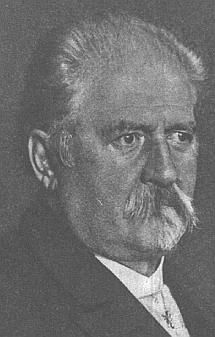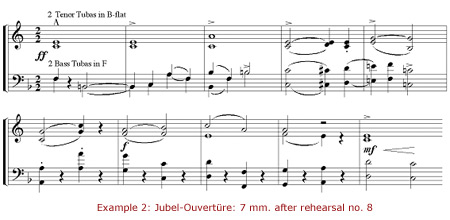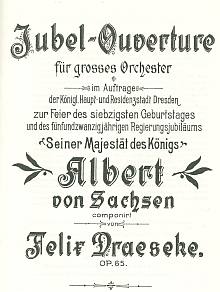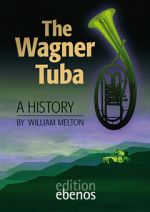Felix Draeseke and the Wagner Tuba
by William Melton
|
|
|
|
|
The repertoire for the Wagner tuba is severely limited, but unsurpassed for sheer quality. The instruments are the sonic embodiment of Valhalla, and attempts to describe their sound have always been fulsome: “solemn, dignified and heroic,” [1] “dark and richly mellow,” [2] “very noble,” [3] “a totally unique, exalted, ceremonial character,”[4] “full and smooth,”[5] “a new brass timbre—something on the dark and smoky side,” [6] “holy and sovereign,”[7] “a profound strength,” [8] “rich, round, solemn,” [9] “a grave majesty,” [10] “very deep and sonorous,” [11] “characteristic tone that is more potent and somber than that of the horn,”[12] “a stately power and hallowed grandeur,” [13] “strange and individual, impossible to describe, and not to be forgotten, once heard.” [14] Yet Wagner tubas have always presented a puzzle, both to prospective composers, and to the players themselves. The former disagreed so widely on how to notate for the instruments that the resultant confusion of transpositions still confounds novice tubists today. And the hybrid construction that produces a majestic sound in the hands of a skilled quartet also guarantees that less expert attempts end in intonational disaster.
They were conceived in the summer of 1853, a gleam in the fertile imagination of Richard Wagner, in Zurich exile after his participation in the Dresden uprising of the Revolution of 1848. More than twenty years would pass before the Wagner tubas made their first appearance in the orchestra (a long and tangled journey to fruition that is documented in the eight articles cited below). But slowly the necessary elements fell into place: the former Viennese hornist Hans Richter lent Wagner the practical expertise that he was missing, and Ludwig II's generous gift of privy funds in January 1874 was followed by a commission to Munich artisan Georg Ottensteiner (trained in Paris during the rise of Adolphe Sax) to create Wagner's new tubas themselves. They were unveiled at a Viennese performance of Ring excerpts led by the composer on 21 February 1875 and were employed at the first Bayreuth Festspiel of 1876. Yet aside from the signal example of Anton Bruckner, composers were loathe to adopt the Wagner tuba over the next few decades. Though Draeseke's studies were made at the Leipzig Conservatory with the Mendelssohnian Julius Rietz, he was afterwards drawn to Wagner and Liszt. Draeseke attended the Ring in Bayreuth in August 1876, and there had a chance to hear the new Wagner tubas. At the end of the month he resettled in Dresden, where in 1884 he became Franz Wüllner's successor as composition teacher at the Conservatory. He often heard the excellent hornists of the Hofkapelle (led by the incomparable Oscar Franz), and composed the Adagio, op. 31, and Romanze, op. 32 for horn and piano[19] in 1885, and the Quintet, op. 48, for piano, violin, viola, cello, and horn[20] in 1888. “With the passing of time Draeseke's relationship to Liszt and New German ideals cooled,”[21] and returning to his early Romantic roots he opposed what he termed the “cacophony” of modern composers. But a close friendship with Jean Louis Nicodé (who conducted a number of Draeseke's works in his concert series) perhaps influenced his inclusion of a quartet of Wagner tubas in the Jubel-Ouvertüre, op. 65. Written for the dual occasion of the 70th birthday and 25th Jubilee of King Albert of Saxony, and first performed by the Dresden Hofkapelle under Ernst von Schuch on 23 April 1898, the score includes two tenor tubas in B-flat (alto) and two basses in F (loco, in so-called “new” bass clef). The horn section that season included solo hornist and Kammervirtuos Oswald Mai, Bruno Franz, Hugo Wünschmann, and Reinhard Beyer, and probable tubists were Karl Krellwitz, Carl Blochwitz, Richard Köhler, and Max Uhlemann [22]. Draeseke wrote in the preface to the work:
Draeseke's tubas play through much of the jovial overture simply doubling the trombones in the rhythmical figures of the tuttis (in Example 1 first bass tuba doubles second trombone exactly), or serving as chordal accompaniment (Example 2). The special color of the tuba quartet is never allowed to be heard in isolation (the B-flat and F instruments often used separately, either unison or singly). The hieratical sense of Wagner and Bruckner is lost in the jolly galloping (Example 3), but is replaced by a new, more muscular style. That Draeseke had departed from Wagner's lead on tuba use was obvious to one observer, who submitted
The author of these lines was Richard Strauss, who had conducted a performance of the Jubel-Ouvertüre in Leipzig on 1 October 1898 for a stellar audience of leading German composers. The “cautionary example” was a very public 1905 rebuke of Draeseke's writing for the tuba quartet. It may also have been an opening salvo that preceded Draeseke's famous condemnation of Strauss in “Die Konfusion in der Musik”[25] the next year.
Wagner and Bruckner, wrote Ingrid Fuchs, had treated “the tuba quartet preferentially, as a group set apart, mostly for quiet ceremonial, solemn utterances” [28]. Dresden hornist August Prée observed, “Because of their unwieldy nature, great technical prowess should not be expected from the tubas.” [29]. This status quo was shattered when Strauss produced the score of Elektra, an about-face from his critique of Draeseke's dancing tubas. Here Strauss went far beyond Wagner in his demands on the instruments, Julian Baker rightly calling the parts "uncompromisingly virtuosic" [30]. The awe-filled handling of the Wagner tuba by late Romantic composers had now been joined by a more athletic writing style, and Igor Stravinsky and Bela Bartók were among many that enthusiastically continued in the new vein. As the century progressed, this raw aspect of the tubas would be exploited in venues as diverse as opera houses, Prussian military bands, and Hollywood films. In hindsight, perhaps Strauss had learned something from Draeseke's dancing tubas after all. [1] Raymond Bryant, “The Wagner Tubas,” Monthly Musical Record 67, Sept. 1937: 153. [2] Dieter Michael Backes, Die Instrumentation und ihre Entwicklung in Anton Bruckners Symphonien, vol. 1 (Diss., Mainz, 1993), 220-221. [3] Anon., The Stage, Feb. 1896, quoted in: John Webb, “Mahillon's Wagner Tubas,” The Galpin Society Journal, 49, March 1996: 2. [4] Friedrich Eckstein, Alte unnennbare Tage! Erinnerungen aus siebzig Lehr- und Wanderjahren (Vienna, 1936), 155. [5] Hans Kunitz, Instrumenten-Brevier (Wiesbaden, 1961), 79. [6] Alfred Frankenstein, A Modern Guide to Symphonic Music (New York, 1966), 179. [7] Karl Geiringer, Instrumente in der Musik des Abendlandes (Munich, 1982), 208. [8] Wolfgang Ruf (ed.), Lexikon Musikinstrumente (Mannheim, 1991), 563. [9] Barry Millington, Wagner (Princeton, 1984), 221. [10] Robin Gregory, The Horn. A Comprehensive Guide to the Modern Instrument & its Music (London, 1969), 177. [11] Paul Schwers, Das Konzertbuch. Sinfonische Werke (Stuttgart, 1940), 201. [12] Bruno Kampmann, “Les Instruments de l'orchestre wagnerien,” Larigot: Bulletin de l'Association des Collectionneurs d'instruments à Vent, no. 13, July 1993: 10. [13] Kurt Janetzky and Bernhard Brüchle, Das Horn. Eine kleine Chronik seines Werdens und Wirkens (Bern and Stuttgart, 1977), 82. [14] Walter Piston, Orchestration (New York, 1955), 294. Comparing the instruments to the bass tuba, Forsyth called the tone "less 'bullocky', quieter, and more 'otherworldish'" (Cecil Forsyth, Orchestration [London, 1935], 153). [15] The confusion is sometimes exacerbated in English by the adoption of the word Tuben directly from the German. An argument for this usage is for precision of expression (to distinguish from the bass tuba): as Jeremy Montagu has written, “the Wagner tuba or, as it is usually known today, the tuben” (The French Horn [Buckinghamshire, 1990], 26). Yet precision is blurred if the singular form (Tube) is ignored, either because of unfamiliarity or because of its acoustical similarity to tuba. This unfamiliarity can easily result in linguistic hash, like the doubly plural title “Wagnerian tubens are growing in popularity” (The School Musician 42, Nov. 1970: 66). Still another usage adds the English plural to the German singular (Tube[-s]). Tradition has it that Hans Richter unwittingly coined the phrase “Wagner tuba,” during rehearsals for the first London Ring : his correct German pronunciation of Tube being understood acoustically by the English musicians as “tuba” (Reginald Morley-Pegge, “The Horn, and the Later Brass,” in: Musical Instruments Through the Ages, ed. Anthony Baines [Harmondsworth, 1978], 315). Whether or not this anecdote is true, the designation Wagner tuba(-s) now carries the advantage of being the most widespread name for the instrument in English. As formulated by Barry Tuckwell, “…the term ‘Wagner Tuba' is convenient and leaves no doubt as to what instrument is intended” (Horn [London & Sydney, 1983], 90). [16] Nicholas Bessaraboff, Ancient European Musical Instruments (Boston, 1941), 144. [17] Hans Kunitz, Die Instrumentation. Ein Hand- und Lehrbuch, vol. 9: Tuba (Leipzig, 1968), 889. Robert Pinson Bobo agreed: “In spite of the fact that a number of authors have written articles about the Wagner Tuben, the material is incomplete, debatable, and somewhat inacessible…” (Scoring for the Wagner Tuben by Richard Wagner, Anton Bruckner and Richard Strauss [DMA Thesis, Miami, 1971], 2). [18] August Göllerich and Max Auer, Anton Bruckner. Ein Lebens- und Schaffens-Bild, vol. 4, part 3 (1890-1896) (Regensburg, 1936), 539. [19] Adagio, op. 31, for horn and piano; Romanze, op. 32, for horn and piano (Leipzig: Kistner, 1885). [20] Quintet, op. 48, for piano, violin, viola, cello, and horn (Leipzig: Kistner, 1888). Draeseke wrote of the work that he had employed the horn “as binding agent for the very different sounds of the keyboard and string instruments.” Martella Gutiérrez-Denhoff, Felix Draeseke: Chronik seines Lebens. Veröffentlichungen der Internationalen Draeseke-Gesellschaft. Schriften, vol. 3 (Bonn, 1989), 92. [21] Alfred Einstein, Das neue Musiklexikon (Berlin, 1926), 155. [22] Private communications from Peter Damm, January 29 and February 19, 2003. Though the original Draeseke parts no longer exist, notations in the Dresden Ring parts for the season of the Jubel-Ouvertüre premiere reveal which players typically played the tubas. Further performances of the Jubel-Ouvertüre in 1898 were given in Leipzig and Berlin. [23] Felix Draeseke, Jubel-Ouvertüre für grosses Orchester, op. 65 (Leipzig: Breitkopf & Härtel, 1898), preface. [24] Forward to Hector Berlioz, Instrumentationslehre, enlarged and edited by Richard Strauss (Frankfurt, 1905). The identity of the composer of the “comic overture” began as an enigma. A surprising number of likely-named overtures had to be vetted, including works by Ferruccio Busoni (Lustspiel-Ouvertüre, op. 38), Hans Huber (Lustspielouvertüre, op. 50), Max Reger (Eine Lustspiel-Ouvertüre, op. 120), Georg Schumann (Lebensfreude Ouvertüre, op. 54), and Felix Weingartner (Lustige Ouvertüre, op. 53). All of these composers knew Strauss. Several were, tantalizingly, less than friendly with Strauss. But none of them included Wagner tubas in their scores. Otherwise authoritative sources were unhelpful in providing specific information. Use of Wagner tubas has been attributed to Felix Draeseke in each of the following: Janetzky and Brüchle, 82; Clifford Bevan, The Tuba Family (London, 1972), 194; Curt Sachs, Handbuch der Musikinstrumente (Wiesbaden, 1979), 280; Stephen Parkany, “Kurth's Bruckner and the Adagio of the Seventh Symphony,” 19 th -Century Music 11, no. 3 (1998): 269, footnote. However, none of these correctly identified the work in question, several hinting misleadingly that Draeseke's Sinfonia Tragica might have included Wagner tubas. It does not. [25] Felix Draeseke, “Die Konfusion in der Musik. Ein Mahnruf,” Neue Musik-Zeitung (Stuttgart, 1906); reprinted in Susanne Shigihara, “Die Konfusion in der Musik. Felix Draesekes Kampfschrift von 1906 und ihre Folgen," Veröffentlichungen der Internationalen Draeseke-Gesellschaft. Schriften, ed. Helmut Loos, vol. 4 (Bonn, 1990). [26] Letter from Richard Strauss to Franz Strauss, May 10, 1893, in Richard Strauss, Briefe an die Eltern 1882-1906, ed. Willi Schuh (Zurich, 1954), 178. [27] Act 2, Scene 3: Ziemlich lebhaft, two mm. after rehearsal no. 128. The band opens its fanfare fortissimo, reducing gradually to piano diminuendo to simulate its departure in the distance. [28] Ingrid Fuchs, “Klingt Bruckner ‘wagnerisch'?” Bruckner Symposion. Bruckner, Wagner und die Neudeutschen in Österreich, ed. Othmar Wessely (Linz, 1986), 115. [29] August Prée, “Die Wagner- oder Horntuben,” in Emil Teuchert and W. W. Haupt, Musik-Instrumentenkunde in Wort und Bild, vol. 3, Messingblas-und Schlaginstrumente (Leipzig, 1928), 27. [30] Julian Baker, “Opera and Ballet,” in The Business, ed. Paul Pritchard (Thames Ditton, Surrey, 1992), 28. Strauss would continue to employ the Wagner tuba in Josephs Legende, Eine Alpensinfonie and Die Frau ohne Schatten. © William Melton 2001-2006 |
|
|
Since graduate studies in historical musicology at UCLA, William Melton has been a career hornist with the Sinfonie Orchester Aachen (after the Leipzig Gewandhaus, the oldest municipal orchestra in Germany), whose music directors in the past have included Wolfgang Sawallisch, Herbert von Karajan, Fritz Busch and Franz Wüllner. Melton's articles have twice won the International Horn Society's Harold Meek Award for scholarship. His biography Engelbert Humperdinck: A Musical Odyssey through Wilhelmine Germany is in preparation at Toccata Press, London, and he has translated Michael Hoeltzel's Mastery of the French Horn (Mainz: Schott, 2006) from the German. Melton's scholarly editions of neglected Romantic works for horn are published by Edition Ebenos. |
|
[Chamber Music] [Orchestral Music] [Keyboard Music] [Music Samples] [Top]
© All contents copyright by the International Draeseke Societies
 Confusion is inherent in their very name. In German alone, they have been known variously as Tuben, Wagner-Tuben, Ring-Tuben, Nibelungen-Tuben, Rheingold-Tuben, Siegfried-Tuben, Bayreuth-Tuben, Tenor-Tuben and Bass-Tuben, B-Tuben and F-Tuben, Horn-Tuben, and Waldhorn-Tuben [
Confusion is inherent in their very name. In German alone, they have been known variously as Tuben, Wagner-Tuben, Ring-Tuben, Nibelungen-Tuben, Rheingold-Tuben, Siegfried-Tuben, Bayreuth-Tuben, Tenor-Tuben and Bass-Tuben, B-Tuben and F-Tuben, Horn-Tuben, and Waldhorn-Tuben [ Its future in the orchestra became a matter of debate, as both Nicolai Rimsky-Korsakov and the influential academic Hugo Riemann condemned its inclusion. Well-known post-Wagnerians like Siegfried Wagner, Hans Pfitzner, Siegmund von Hausegger, August Bungert and Max von Schillings declined to take up the instruments. Engelbert Humperdinck, whose admiration for Wagner was unlimited, explicitly cautioned against casual employment of the tuba quartet: “The use of four tubas and daring harmonic progressions are in the end merely superficialities, and they have nothing to do with the actual essence of Wagner's art.”[
Its future in the orchestra became a matter of debate, as both Nicolai Rimsky-Korsakov and the influential academic Hugo Riemann condemned its inclusion. Well-known post-Wagnerians like Siegfried Wagner, Hans Pfitzner, Siegmund von Hausegger, August Bungert and Max von Schillings declined to take up the instruments. Engelbert Humperdinck, whose admiration for Wagner was unlimited, explicitly cautioned against casual employment of the tuba quartet: “The use of four tubas and daring harmonic progressions are in the end merely superficialities, and they have nothing to do with the actual essence of Wagner's art.”[


 Strauss himself had approached Wagner tubas with circumspection. The twenty-eight year old began by writing his hornist father Franz in May, 1893: “Would you please be so good as to find out how to write for tenor horns, in which key, and their range: 1. What is altogether possible, 2. How high and how low are truly comfortable? I need them for the stage music at the end of the second act [of the opera Guntram, op. 25], where I want to use them in place of horns.”[
Strauss himself had approached Wagner tubas with circumspection. The twenty-eight year old began by writing his hornist father Franz in May, 1893: “Would you please be so good as to find out how to write for tenor horns, in which key, and their range: 1. What is altogether possible, 2. How high and how low are truly comfortable? I need them for the stage music at the end of the second act [of the opera Guntram, op. 25], where I want to use them in place of horns.”[